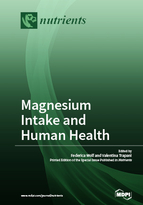Magnesium Intake and Human Health
A special issue of Nutrients (ISSN 2072-6643).
Deadline for manuscript submissions: closed (1 June 2018) | Viewed by 164750
Special Issue Editors
Interests: magnesium homeostasis; magnesium transport; magnesium channels; oxidative stress; cancer cells; cellular aging; signal transduction; IBD and gut microbiota, food supplements and health
Special Issues, Collections and Topics in MDPI journals
Interests: magnesium absorption; magnesium channels; cell proliferation; human diseases, preventive medicine, aging
Special Issues, Collections and Topics in MDPI journals
Special Issue Information
Dear Colleagues,
Magnesium is universally recognized as an essential nutrient for human life and health. Indeed, magnesium plays an important physiologic role in every organ of the human body. Disturbances of Mg homeostasis have, therefore, been implicated in the pathophysiology of several diseases, and Mg supplementation has been evaluated in some large-scale clinical trials. The World Health Organization listed magnesium among those essential nutrients that are consumed in suboptimal amounts by the general population. In particular, this occurs in Western ("Westernized") countries, where a modest to mild Mg2+ deficiency is thought to be common. The consequences of suboptimal Mg intake are largely unknown. A deeper understanding of the link between magnesium intake, its systemic homeostasis, and human pathophysiology is therefore much needed and may foster the development of preventive and/or therapeutic measures.
Here, we invite the experts to contribute original research or review articles that illuminate the role of Mg in pathophysiologic conditions and may help to develop novel therapeutic strategies. Potential topics include, but are not limited to:
-
Role of magnesium deficiency in cardiovascular, metabolic, neuronal and neoplastic disorders;
-
Role of magnesium transporters and channels in different tissues, cell signalling and disease;
-
In vitro and in vivo studies on the effects of Mg2+ deficiency and/or supplementation on relevant pathologies;
-
Novel formulations of magnesium supplements and/or magnesium absorption.
Prof. Federica I. Wolf
Dr. Valentina Trapani
Guest Editors
Manuscript Submission Information
Manuscripts should be submitted online at www.mdpi.com by registering and logging in to this website. Once you are registered, click here to go to the submission form. Manuscripts can be submitted until the deadline. All submissions that pass pre-check are peer-reviewed. Accepted papers will be published continuously in the journal (as soon as accepted) and will be listed together on the special issue website. Research articles, review articles as well as short communications are invited. For planned papers, a title and short abstract (about 100 words) can be sent to the Editorial Office for announcement on this website.
Submitted manuscripts should not have been published previously, nor be under consideration for publication elsewhere (except conference proceedings papers). All manuscripts are thoroughly refereed through a single-blind peer-review process. A guide for authors and other relevant information for submission of manuscripts is available on the Instructions for Authors page. Nutrients is an international peer-reviewed open access semimonthly journal published by MDPI.
Please visit the Instructions for Authors page before submitting a manuscript. The Article Processing Charge (APC) for publication in this open access journal is 2900 CHF (Swiss Francs). Submitted papers should be well formatted and use good English. Authors may use MDPI's English editing service prior to publication or during author revisions.
Keywords
-
Cardiovascular disease
-
Metabolic disorders
-
Age-related conditions
-
Inflammatory bowel diseases
-
Magnesium supplements








